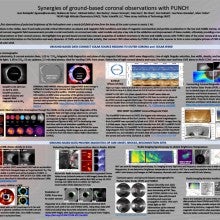Synergies of ground-based coronagraph observations with PUNCH
Joan
Burkepile
National Center for Atmospheric Research (NCAR)
Giuliana deToma - NCAR
Michael Galloy - NCAR
Ben Berkey - NCAR
Steve Tomczyk - Solar Scientific LLC
Michael Galloy - NCAR
Ben Berkey - NCAR
Steve Tomczyk - Solar Scientific LLC
Oral and Poster
The PUNCH mission will deliver the first observations of polarized light from the outer corona through the inner heliosphere over a full field-of-view, providing crucial information for reconstructing the three-dimensional morphologies and evolution of ambient and dynamic solar wind structures. The past decades have seen ground-based coronal observations increase in quality and variety, providing a treasure trove of pivotal and complementary observations to space-based data. Ground-based observations of the low and middle corona connect the solar source regions to the outer corona and heliosphere as observed from space. They provide a wealth of observations used to:
• Study properties of MHD waves in the corona that are a source of coronal heating;
• Provide plane-of-sky magnetic field maps, and line-of-sight magnetic field strength in the low corona;
• Measure dynamical properties of CMEs from onset and into the middle corona including expansion, acceleration, plane-of-sky density, plasma motions, and diagnostics of turbulent flows within CMEs;
• Detect CME morphological changes that are clues to the location of CME-shock formation;
• Locate sites of magnetic reconnection and high energy electrons;
• Identify coronal morphologies such as pseudo-streamers and magnetic flux ropes
• Track jets, blobs and flows from the low to middle corona
We highlight how ground-based coronal observations can be combined with new observations from PUNCH, and other space-based coronal data, to address the fundamental questions in heliophysics.
• Study properties of MHD waves in the corona that are a source of coronal heating;
• Provide plane-of-sky magnetic field maps, and line-of-sight magnetic field strength in the low corona;
• Measure dynamical properties of CMEs from onset and into the middle corona including expansion, acceleration, plane-of-sky density, plasma motions, and diagnostics of turbulent flows within CMEs;
• Detect CME morphological changes that are clues to the location of CME-shock formation;
• Locate sites of magnetic reconnection and high energy electrons;
• Identify coronal morphologies such as pseudo-streamers and magnetic flux ropes
• Track jets, blobs and flows from the low to middle corona
We highlight how ground-based coronal observations can be combined with new observations from PUNCH, and other space-based coronal data, to address the fundamental questions in heliophysics.

Poster PDF
Presentation file
YouTube link
Meeting homepage